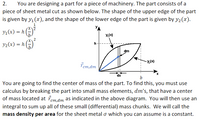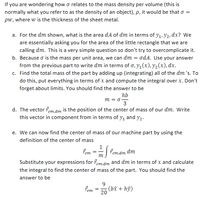
Elements Of Electromagnetics
7th Edition
ISBN: 9780190698614
Author: Sadiku, Matthew N. O.
Publisher: Oxford University Press
expand_more
expand_more
format_list_bulleted
Concept explainers
Question
a, b, and c

Transcribed Image Text:2.
You are designing a part for a piece of machinery. The part consists of a
piece of sheet metal cut as shown below. The shape of the upper edge of the part
is given by y, (x), and the shape of the lower edge of the part is given by y2(x).
Y1(x) = h
y,(x)
y2(x) = h
b.
dm
Tem,dm
dx
b
You are going to find the center of mass of the part. To find this, you must use
calculus by breaking the part into small mass elements, dm's, that have a center
of mass located at em dm as indicated in the above diagram. You will then use an
integral to sum up all of these small (differential) mass chunks. We will call the
mass density per area for the sheet metal o which you can assume is a constant.

Transcribed Image Text:If you are wondering how o relates to the mass density per volume (this is
normally what you refer to as the density of an object), p, it would be that o =
pw, where w is the thickness of the sheet metal.
a. For the dm shown, what is the area dA of dm in terms of y1, Y2, dx? We
are essentially asking you for the area of the little rectangle that we are
calling dm. This is a very simple question so don't try to overcomplicate it.
b. Because o is the mass per unit area, we can dm = odA. Use your answer
from the previous part to write dm in terms of o, y,(x),y2(x), dx.
c. Find the total mass of the part by adding up (integrating) all of the dm 's. To
do this, put everything in terms of x and compute the integral over x. Don't
forget about limits. You should find the answer to be
hb
m = o=
3
d. The vector iem,.âm is the position of the center of mass of our dm. Write
this vector in component from in terms of y, and y2.
e. We can now find the center of mass of our machine part by using the
definition of the center of mass
Tem
: Fem.dm dm
m
Substitute your expressions for Tem.dm and dm in terms of x and calculate
the integral to find the center of mass of the part. You should find the
answer to be
9
Tem
(bî + hŷ)
20
Expert Solution
This question has been solved!
Explore an expertly crafted, step-by-step solution for a thorough understanding of key concepts.
This is a popular solution
Trending nowThis is a popular solution!
Step by stepSolved in 3 steps with 3 images

Knowledge Booster
Learn more about
Need a deep-dive on the concept behind this application? Look no further. Learn more about this topic, mechanical-engineering and related others by exploring similar questions and additional content below.Similar questions
- number d and e?arrow_forwardExpress: 50000mm3 as m3 3.5m3 as mm3 20m3 as cm3 45cm3 as m3arrow_forward1.Impulse of a force is the integral of the force with respect to time over the time the force is applied. Impulse of a force is the integral of the force with respect to time over the time the force is applied. True Falsearrow_forward
Recommended textbooks for you
 Elements Of ElectromagneticsMechanical EngineeringISBN:9780190698614Author:Sadiku, Matthew N. O.Publisher:Oxford University Press
Elements Of ElectromagneticsMechanical EngineeringISBN:9780190698614Author:Sadiku, Matthew N. O.Publisher:Oxford University Press Mechanics of Materials (10th Edition)Mechanical EngineeringISBN:9780134319650Author:Russell C. HibbelerPublisher:PEARSON
Mechanics of Materials (10th Edition)Mechanical EngineeringISBN:9780134319650Author:Russell C. HibbelerPublisher:PEARSON Thermodynamics: An Engineering ApproachMechanical EngineeringISBN:9781259822674Author:Yunus A. Cengel Dr., Michael A. BolesPublisher:McGraw-Hill Education
Thermodynamics: An Engineering ApproachMechanical EngineeringISBN:9781259822674Author:Yunus A. Cengel Dr., Michael A. BolesPublisher:McGraw-Hill Education Control Systems EngineeringMechanical EngineeringISBN:9781118170519Author:Norman S. NisePublisher:WILEY
Control Systems EngineeringMechanical EngineeringISBN:9781118170519Author:Norman S. NisePublisher:WILEY Mechanics of Materials (MindTap Course List)Mechanical EngineeringISBN:9781337093347Author:Barry J. Goodno, James M. GerePublisher:Cengage Learning
Mechanics of Materials (MindTap Course List)Mechanical EngineeringISBN:9781337093347Author:Barry J. Goodno, James M. GerePublisher:Cengage Learning Engineering Mechanics: StaticsMechanical EngineeringISBN:9781118807330Author:James L. Meriam, L. G. Kraige, J. N. BoltonPublisher:WILEY
Engineering Mechanics: StaticsMechanical EngineeringISBN:9781118807330Author:James L. Meriam, L. G. Kraige, J. N. BoltonPublisher:WILEY

Elements Of Electromagnetics
Mechanical Engineering
ISBN:9780190698614
Author:Sadiku, Matthew N. O.
Publisher:Oxford University Press

Mechanics of Materials (10th Edition)
Mechanical Engineering
ISBN:9780134319650
Author:Russell C. Hibbeler
Publisher:PEARSON

Thermodynamics: An Engineering Approach
Mechanical Engineering
ISBN:9781259822674
Author:Yunus A. Cengel Dr., Michael A. Boles
Publisher:McGraw-Hill Education

Control Systems Engineering
Mechanical Engineering
ISBN:9781118170519
Author:Norman S. Nise
Publisher:WILEY

Mechanics of Materials (MindTap Course List)
Mechanical Engineering
ISBN:9781337093347
Author:Barry J. Goodno, James M. Gere
Publisher:Cengage Learning

Engineering Mechanics: Statics
Mechanical Engineering
ISBN:9781118807330
Author:James L. Meriam, L. G. Kraige, J. N. Bolton
Publisher:WILEY